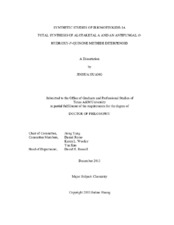| dc.description.abstract | Natural products are a rich source of compounds with interesting structures and biological activities. Three bioactive natural products, iriomoteolide-1a, alotaketal A, and an unnamed quinone methide diterpenoid, attracted our attention during our course of exploring natural products as potential leads for biomedical discovery.
The structure of iriomoteolide-1a had been misassigned, but the potent cytotoxicity reported for this natural product warranted further studies to elucidate its true structure. As part of our effort toward this goal, we finished the total synthesis of a diastereomer of iriomoteolide-1a. Our total synthesis featured a lithium acetylide-chloroformate coupling to assemble the alkyne and chloroformate fragments, the ring closing metathesis to exclusively generate the 15E-macrocyclic diolide, and a SmI_(2)-mediated intramolecular reductive allylation to form the cyclic hemiketal. The bioactivities of this diastereomer were evaluated, but only weak inhibition of cell proliferation was observed at 10 µM toward HeLa and PC3 cell lines.
Alotaketal A was reported to potently (EC_(50) = 18 nM) activate the cAMP (cyclic adenosine monophosphate) signaling pathway in HEK293 cells transformed with the pHTS-CRE plasmid. Our synthetic efforts toward this natural product culminated in the first enantioselective total synthesis of (-)-alotaketal A. Our total synthesis employed both intra- and inter-molecular reductive allylation of esters for assembling the bicyclic lactone and coupling the fragments. A Hg(OAc)_(2)-mediated allylic mercuration was used to introduce the C22-hydroxyl group. The subtle influence of substituents over the course of the spiroketalization process was revealed. The synthesis confirmed the relative and absolute stereochemistry of (-)-alotaketal A and allowed verification of alotaketal A’s effect over cAMP signaling using reporter-based FRET imaging assays with HEK293 cells. Our studies also revealed alotaketal A’s unique activity in selectively targeting nuclear PKA signaling in living cells.
Our synthetic efforts toward the unnamed quinone methide diterpenoid 1.67 led to the first total synthesis of this potent antifungal product (MIC = 0.19 µM). Our total synthesis was highlighted by a Stille coupling to introduce the allyl group, a lithium/naphthalene-mediated coupling reaction for fragment assembling, and a BBr3-mediated one-pot bis-demethylation and intramolecular Friedel-Crafts alkylation to build the tricyclic molecular framework. Our preliminary structure-activity relationship study showed that the 2'-hydroxyethyl side chain of the natural product was nonessential to its antifungal activity. | en |


